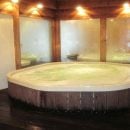Homeowners sometimes find that their homes are built such that some windows or doors directly face where sunlight and heat are at a maximum. Excessive exposure to the sun is also a concern for decks, the house entrance and patios for specific seasons.
In addition, it happens that one gets home and is unable to immediately find the house keys. If the door or front of the house is not adequately covered, fumbling for the keys can be an uncomfortable experience when one is under the hot sun or is being drenched by the rain.
These problems can be resolved using canopies or awnings. These protective shades are generally cost-effective and feature lightweight skeletal frames. An awning or canopy can be made from a composite material, fabric or even aluminum, and some come in retractable models with manual or electric control.
1. Canpopies Are Just Plain Enjoyable
Retractable and roll-up canopies give the owner the option of fully extending the shade during summer and rolling it up during the winter. This is ideal particularly for the deck, which many use as comfortable place to take a nap. The shade also allows one to enjoy the outdoors regardless of the season. Some canopies are even wired into the frame, so that homeowners can also use what is effectively extended living space at night.
2. Avoid Having To Pay For As Much Air Conditioning During Summer
Figures from the US Department of Energy show that awnings can lower summer heat on windows facing the south by 65%, while eastern and western facing windows reduce such heat gain as much as 77%. This could, therefore, lower your total electricity bills during summer as you will need to spend less on air conditioning.
3. Reduce Monitor Glare And Protect Windows
The woodwork around windows is also protected from snow and rain by awnings and canopies, while furniture on the porch or patio are also shielded from the elements. Open windows are possible for a home even on rainy days with awnings. PC monitors and television sets near windows on sunny days will benefit from the reduced glare due to the awnings – an indication that the cooling effect of a canopy is not limited to the outside. The extension of this effect indoors has helped some homeowners limit use of air-conditioning during the summer and lower their electric bills.
4. Materials
Homeowners have a choice between outdoor fabric and aluminum as the material for their canopies. Advantages of an aluminum canopy include sturdiness and low-maintenance, although shape and color options are limited. If the shade is made of fabric, it would entail greater care and maintenance, although more colors and shapes are available for this material type. Both alternatives are possible for casement windows.
Personal preference and energy efficiency standards are key guides to determining the canopy size and drop, or the amount of shade or coverage provided. The Energy Department sets 65%-75% as the maximum efficiency range for canopies covering windows facing the east and west. For the south-facing side, the agency recommends a lower coverage range of 45%-60%.
5. Style Vs Function
The choice in terms of size will involve a trade-off: some individuals may prefer larger awnings to maximize protection and coverage, while others may prefer smaller ones when more premium is placed on the decorative impact. If emphasis is given to aesthetics, many manufacturers already offer canopies and related accessories in various shapes, designs and colors. It should be noted that coverage by canopies or awnings can be enhanced by using side panels, although these are not necessary. Special canopy models are also in the market for windows that open to the outside.
6. Added Benefits
Some canopies are also designed for easy assembly and portability, making it possible to disassemble and transfer them to areas around the house where they are most needed. These mobile canopies typically feature braces or arms, rollers, horizontal rafters and fabric shades or vinyl blinds and are also applicable to recreational vehicles or trailers. Once the target area for shading is determined, homeowners can establish the ideal canopy width size and the number of sections needed for coverage.
Since canopy cuts vary in size, knowing the measurements of the area will help the owner decide on the most cost-effective combinations. Some awning or canopy manufacturers offer track extenders to accommodate slight adjustments in measurement. Once measurement issues are settled, the owner now has the option to pursue installation as a do-it-yourself project or to seek professional assistance from authorized dealers.





 Outdoor Glider Furniture
Outdoor Glider Furniture Home Remodeling Tools
Home Remodeling Tools How to Plan and Estimate
How to Plan and Estimate Laminate Flooring for Remodeling
Laminate Flooring for Remodeling Reduce Home Remodeling Stress
Reduce Home Remodeling Stress